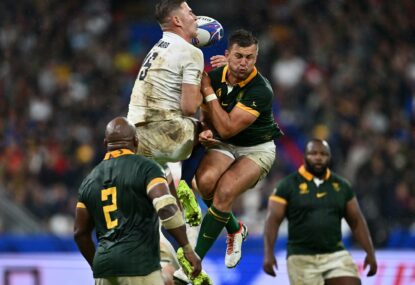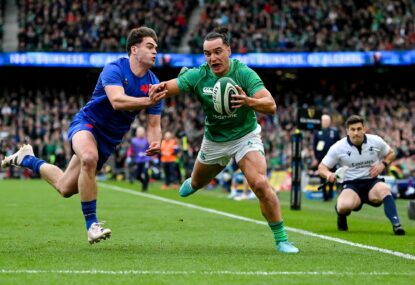For the first 60 minutes of their Six Nations match, England were flummoxed by Italy’s brilliant defensive strategy, to the point where the Italians led at halftime.
As an Englishman it was frustrating to watch, but Conor O’Shea’s spoiler tactics were genius.
The tactics were designed not to let England release their players and play the wide game Eddie Jones has implemented.
O’Shea knew they needed to take out England’s 10-12 axis. All the width in England’s game comes from the twin playmaking and distributing influence that George Ford and Owen Farrell bring.
Italy could’ve charged down Ford, knowing he stands flat, and therefore put him under increased pressure. Instead, they took the smarter option, and negated him altogether.
It totally cut Ford off from the back line, negating one of England’s most potent weapons, the ball in hand.
This was pure genius, not cynicism, and while maybe not in the spirit of the game, it was totally legal, and stopped England. It has been done before, though never to the scale O’Shea implemented against England, and Jones’ fury at the Italians was unjustified.
Over the past year, England have been able to think on their feet, notably in the June series against the Wallabies, but this was so out of the bag, I’m not certain any of them expected it. The fact that it took so long to counter, is where I feel Jones’s real fury will be aimed at.
It is not hard to envision that if you can’t move the ball wide, drive straight through the middle, maul it and pick and go. Traditionally, we English are great at that! The defence there will be far less constricted, so our pack can make metres.
Yet the coach needed to tell them to do what should be second nature. That will not have been lost on Jones, and highlights the need for more leaders in the team.
However, once England became aware of how to combat the tactic they were much more like the team we know.
Scotland will have not been able to gather as much information from this game as they would like, as England’s attacking verve only shone through in the last 20 minutes. However, one big area exposed to target was the scrum.
Italy shoved England off their own ball in the scrums. Scotland will hit hard in the scrums, focus on Dan Cole and try and draw penalties.
Where the Scots also have an edge is in the backrow and breakdown, as England don’t have an out-and-out fetcher and Scotland have some very good ones.
The Scots may have also gained knowledge of England’s wide attacking patterns, particularly within the 15m line.
After going wide, England spend a phase or two moving across the field.
The first phase sees a hard running backrower within five metres of the ruck, the second has a front row or lock run at the midfield. These are usually one-off runners while Ford organises the wide attacking pattern that will be used in the third phase.
There are four options that I have seen where Ford and Farrell combine to move the ball to exploit open space. Three of them are used after the two-phase crossfield play, one is used after one phase instead.
Switchback
Ford stands behind the ruck on the first phase, indicating where the next forward will hit. Usually opposition teams know that England’s runners are coming in these positions, and as they are heavy runners, numbers have been known to move over from the blind side to the open side prematurely.
Ben Youngs can also hit the first or second runner, so numbers must move across to cover both options, which is where having a dual playmaker axis is so effective.
Ford is able to move around on a switch from Youngs to the blind, and with a heavy runner and wing, is able to make metres, exploiting the lack of numbers caused by moving over to the open in preparation for England’s hard runners.
This pattern is arguably the flattest England play, due to the limited space on the blind (10-15 metres), and why Ford usually runs it, as he is more comfortable playing flat than Farrell.
This leads to defenders moving over to cover the shortside, creating space on the other side of the 15-metre line, where Youngs can then repeat the process with England’s heavy runners, originally planned for phase one or two, given more space.
Alternately, due to Farrell being on the open, he can circumvent the two-phase play and slot in at first receiver to generate width and hit up space created on the open wide channels.
This is where the 10-12 axis really comes into its own. Decisions can be made quicker as Farrell can slot in on the other side of ruck if it’s on, instead of going through pre-programmed plays.
Flat play
This is where 10-12-13-14 and 15 line up after said phases, and move it wide. Best used after the switch-back pattern, it allows faster runners in the backs to target the spaces created in the centre of the pitch, and shift it wide if necessary.
Te’o
From the second phase runner, this usually involves Ben Te’o.
Ford will take the ball flat, and pass behind a hard running forward to Farrell, who will then have a short pass option in Te’o, or can use him as a decoy to let loose the wings.
This move was seen against Wales, with Teo’s break in the second half, getting two heavy runners in the forward and Te’o sucking in defenders, freeing up space for the wings, who if nothing else can speed into space nicely.
Two line
This is the most clever option, due to positional allocations that England make in its implementation.
After the second phase, if a clear overlap has been formed, Ford will have two lines, the front line comprising locks, and a hard-running power runner prop at the end, who’ll reach up to the 15m line.
Farrell is usually two metres behind the prop, and approximately the same distance inside. He is the start of the second line, which runs from the 15m line to the touchline. It mostly comprises three-quarter players, the openside winger, and a loosie for ball retention. These lines are very flat to each other, which reduces the space the defending team has to drift.
Ford will run the ball flat and throw a miss pass, with the inside defenders preventing the defence drifting early.
This not only means the defence are less likely to rush hard, but also that opposition wingers can be brought up flat to help their colleagues when the tackle inevitably comes. Which it doesn’t.
The prop role in this move involves taking the ball to the line, drawing the back-three defenders flat, and preventing the rush up defence that will cut off the next phase.
The next phase involves the prop passing inside to Farrell in a loop play, where he can – due to the flatness of his line – distribute the ball down the second line, who have little space to get past the last defender, who has been brought up flat due to the run of the prop.
These structures may come across as strict, and they are, but only in terms of their execution. Jones has given his players a framework, but within that framework the options are fluid, and it is not a rugby by numbers approach, but uses the decision-making of 9, 10 and 12.
As such, they use these options in coordination with what they see in front of them to maximise chances when in space.
That is where the old Jones has changed to the new Jones. He’s still evil, but he gives his players the tools and they have their own discretion as to how they’re used based on what’s in front of them.
The way to stop these structures is at the source. Scotland must restrict England’s speed of ball in the first and second phases with the power runners. Scotland’s defence need to be very organised and, like Wales, aim for turnovers and to be physical at the gainline.



































































































